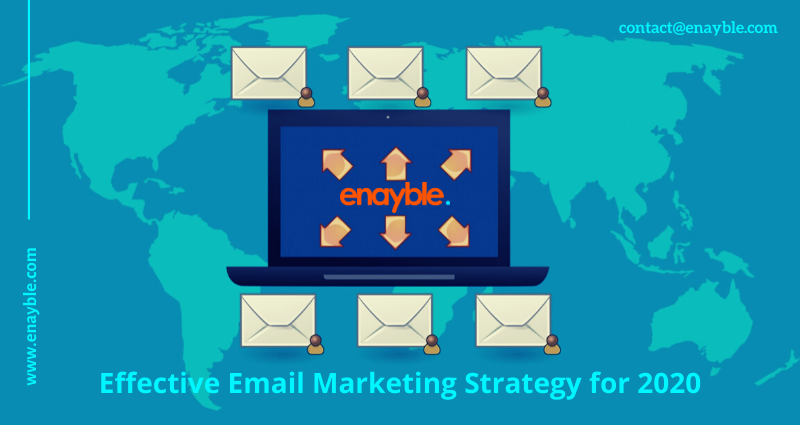Effective Email Marketing Strategy For 2020

Digital marketing offers several effective tools to help marketers place their brands on the map, but e-mails have been the most preferred mode for reaching out to customers since the beginning of time. While the prevalence of social media might make marketers think that email marketing ideas have been superseded, but that is not the case. Email marketing tactics are still at par with social media and other methods, as it continues to advance, adjust, and evolve.
Its brand awareness and customer acquisition no longer measure a company’s credibility; rather, it is judged on its customer interaction, engagement, and accessibility. A company’s viability now depends on the way marketers engage with their customers and it eventually impacts the revenue.
According to reports and surveys, it is estimated that about 247 billion emails were sent per day in 2010, as compared to a predicted amount of 307 billion per day in 2020. Given the impact email marketing still has on the market and consumers, it is paramount for businesses to stay on top of their email marketing game.
Here are some trends that are likely to help advance the email marketing strategy in 2020:-
1. User-Generated Content:
UGC is any form of content, text images, audio and visual, created by the end-user of the product. Like other channels, user-generated content enables real-time customer engagement between brand evangelists and their prospects at the same time. Motivating and incentivizing the customers to contribute their content through email marketing promotes the authenticity and credibility of the brand, directly influencing the conversion rates.
According to e-commerce leader 3dcart, 82 percent of customers think that user-generated content is valuable and informative and 70 percent of consumers check for reviews and ratings before buying a product. Additionally, email subscribers are three times more likely to share content on social media than other platforms; email marketing creates a symbiotic relationship with social media, multiplying user-generated content to leverage in the future.
It is not difficult to gather user-generated content from email marketing. Knowing how, when, and why to ask for reviews and feedback is the first step to start with. Asking simple questions that direct to a survey can help solve the issue “how.” Knowing when to ask for feedback is essential for better results. It is crucial to give the user a chance to experience the product and form his opinion around it. Selecting the right form of email marketing framework for the organization helps to extend the feedback outreach and help gather more content.
2. Interactivity Encourages Engagement:
In 2020, most emails will be opened on a mobile device than a desktop or laptop. It is highly likely that users will delete the emails without reading the subject even if they are not interested, or the email is not optimized for the device. Therefore, following a multi-device approach is going to help the emails to survive.
The collaboration of interactivity and responsiveness poses a challenge for even the smartest email marketers. Back in the old days, interactivity was designed for the entertainment of the recipient, but in 2020, it will be used to drive engagement and in a more practical way to get the consumers’ undivided attention. Here are some elements that are expected to be seen in emails this year:
· Animated call-to-action buttons
· Effects to showcase product specifications
· Accessible product carousels and interactive imaging
· Polls, surveys, and user-generated interactive content
3. Enhanced Accessibility:
In 2020, we will continue to see a rise in voice assistants and smart speakers reading emails out loud to recipients. With more than 250 million smart speakers to be installed in 2020, smart email marketers are already designing emails with keeping accessibility at the forefront.
According to the World Health Organization, 1.3 billion people are living with visual impairments, and 36 million of them are considered blind. This acts as a delicate challenge for email marketers because accessibility gets hampered, and some segments of the target audience get neglected unknowingly.
While highly accessible emails seem like a tough task, the improvement of assistive technologies has made the process a little easier for the readers and marketers alike. Here are some attainable ways to make emails accessible to every reader:
· Content: It is better to keep emails precise and clean. According to pools, the average attention span of an email is only 13.4 seconds, and a reader can read from 250-300 words in a minute. Therefore, the ideal length of the email copy can be around 50 words. Here are some tips for a concise email copy:
§ Try using shorter sentences
§ Limit the use of jargon and difficult-to-read words
§ Localizing the content for a global audience
· Design: A more accessible design involves removing all email templates and flashy images that make the screen look cluttered. The clear and crisp design makes the text looks better and readable.
§ Strong visual hierarchy in the email template
§ Avoiding long sections and center-justified texts
§ Using appropriate and uniform font sizes
§ Optimizing line spacing and paragraph spacing
§ Using proper color-coordination
· Code: A sure-fire way to create accessible emails for readers is to manipulate the code in such a way that it works for every user. Assistive technologies assess the code as the first step. Having a robust code-base behind the email is the best way to ensure accessibility.
Email accessibility is not a tough feat to achieve, but each small step matters. Increasing usability and accessibility promotes the inclusion and increments in ROI.
4. Email Automation:
The last decade experienced significant advancements in automation, and the next decade is going to change the way we look at automation entirely. Email integration is a fast-moving train today. Marketing cloud services have successfully leveraged data processing and power, allowing improved statistics, cross-channel optimization and carved a path for machine learning, artificial intelligence, and big data to rule the email marketing landscape in 2020.
Machine learning and deep learning are going to help marketers to set a benchmark more efficiently in all email marketing factors. The automation of customer’s life-cycle and workflow is expected to increase. This smarter segmentation will lead to better performance, customization, and accessibility. Automated reporting will lighten the burden of email marketers and cut costs, leading to increased user retention.
5. Personalized Content :
Personalized content and creating segmented email lists are the two main factors that are going to make email marketing campaigns successful in 2020. Effectively segmenting the audience according to age, behavior, preferences, and region will help create better-personalized content. The click-through rates of personalized emails are much higher than emails containing general information.
Vision for 2020:
The future of email marketing is promising as it continues to shift and evolve in the digital marketing landscape. Advancements in almost every aspect of this channel are going to help marketers use email marketing to its full potential, be more impactful and accurate, a delight in every reader’s inbox.
